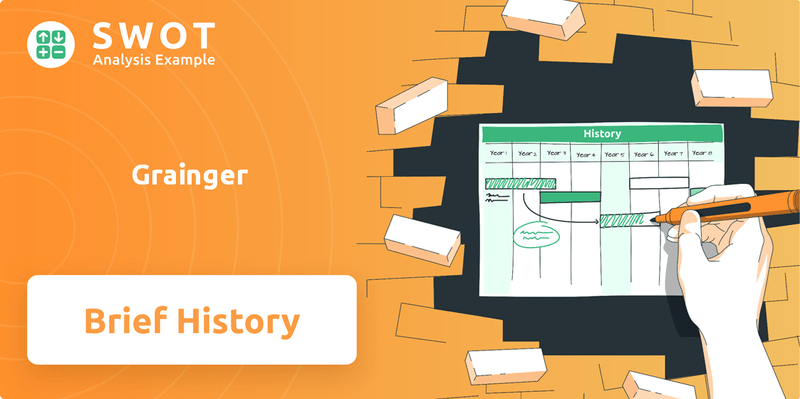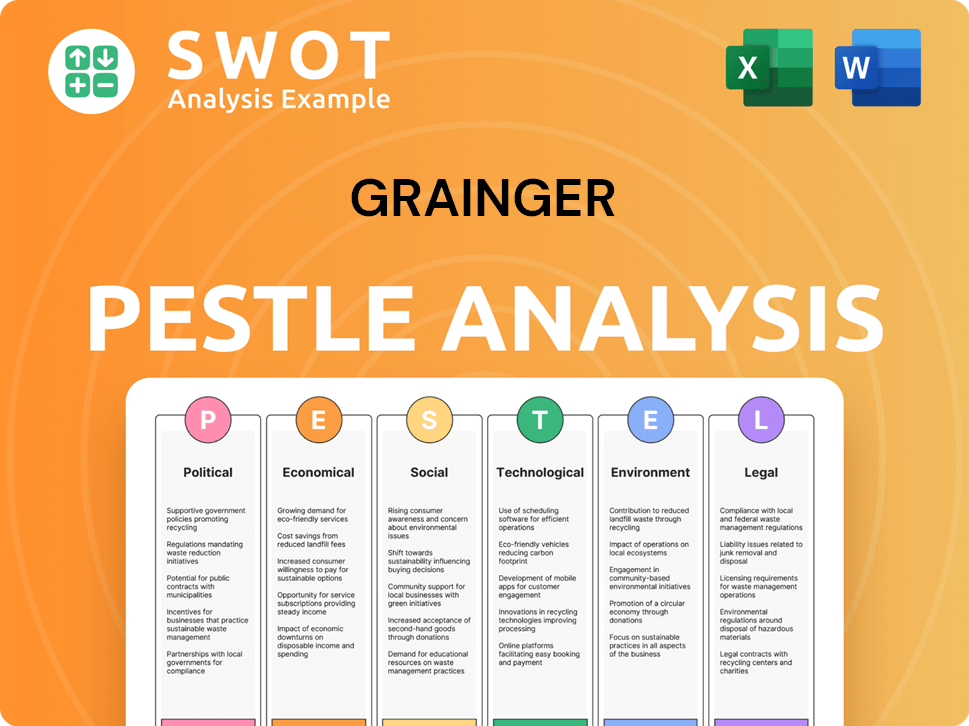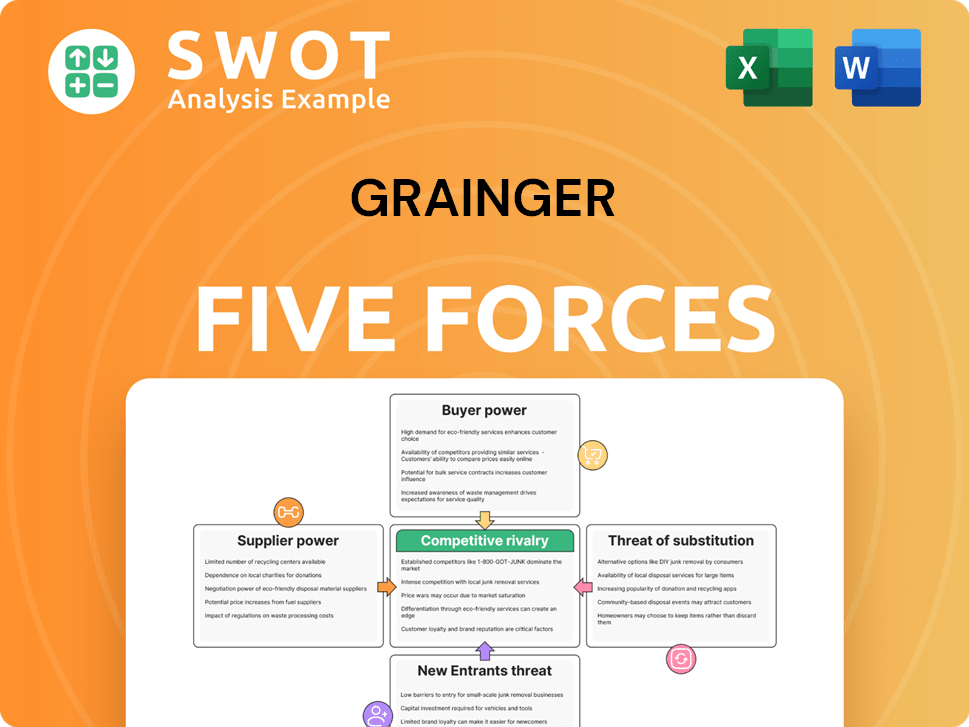Grainger Bundle
How Did W.W. Grainger Become an Industrial Powerhouse?
In the realm of industrial supplies, few names resonate as strongly as W.W. Grainger, Inc. But how did this company, now a global leader, begin its journey? The Grainger SWOT Analysis reveals the company's strategic evolution. This brief history of W.W. Grainger will explore the pivotal moments that shaped its trajectory.

The story of W.W. Grainger, from its humble beginnings in 1927, is a compelling narrative of adaptation and innovation. From its origins as a provider of electrical motors, the Grainger company has expanded to offer a vast array of Grainger products. Understanding the Grainger founder's vision and the Grainger timeline provides valuable insights into its enduring success and market position.
What is the Grainger Founding Story?
The Grainger company has a rich history, beginning with its establishment on March 25, 1927. The company's origins are rooted in the vision of William W. Grainger, an electrical engineer who identified a critical need in the market.
Grainger's initial focus was on supplying electrical motors, a crucial component for industrial operations. This early business model was innovative, emphasizing direct sales to customers through a catalog, which streamlined the purchasing process. The company's early success was built on its ability to provide essential industrial components efficiently.
The Grainger company's history starts with its founder, William W. Grainger, an electrical engineer.
- Grainger founder: William W. Grainger
- Founding Date: March 25, 1927
- Initial Focus: Wholesale distribution of electrical motors
- Business Model: Catalog-based sales, direct to customers
- Initial Funding: Personal savings and small loans
The company, initially named W.W. Grainger, Inc., began with a focus on electrical motors. This was a strategic choice, given the burgeoning industrialization of the late 1920s. The company's ability to provide these essential components directly to customers was a key differentiator.
The early days of the Grainger company were marked by a commitment to meeting the needs of industrial customers. The company's direct-to-customer model and catalog-based sales approach were innovative for the time, streamlining the purchasing process for businesses. The company's initial funding came from William W. Grainger's savings and possibly small loans, reflecting the bootstrapping nature of the venture.
Grainger SWOT Analysis
- Complete SWOT Breakdown
- Fully Customizable
- Editable in Excel & Word
- Professional Formatting
- Investor-Ready Format

What Drove the Early Growth of Grainger?
The early years of the Grainger company, saw steady growth fueled by its catalog sales and customer service. Founded in 1927, the company expanded its offerings beyond electrical motors to include a broader range of MRO products. This expansion included the publication of its first motor book, which evolved into the extensive catalogs known today.
After its founding, the company began establishing branch locations to better serve its growing customer base, moving beyond its initial Chicago headquarters. This geographical expansion allowed for quicker delivery and more personalized service. The company's ability to maintain a strong market reception was due to its reliable supply chain and consistent product availability, which were crucial for businesses reliant on MRO supplies.
The mid-20th century saw the company continue its ascent, adapting to the post-World War II industrial boom. The company focused on expanding its product categories to meet the diverse needs of businesses across various sectors, including manufacturing, government, and healthcare. Key developments included the introduction of new product lines such as hand tools, safety equipment, and material handling products.
While specific major acquisitions or mergers in the very early years are less documented, the company's growth was primarily organic, driven by an expanding product portfolio and a widening distribution network. Leadership transitions were also key, as the company moved from its founder's direct oversight to a more formalized corporate structure, enabling further scalability. By the end of 2023, the company reported over $16.3 billion in sales, a testament to its sustained growth.
Key milestones in the Grainger history include the evolution of its catalog, which became a central tool for customers. The company's early focus on customer service and reliable supply chains solidified its market position. The expansion of branch locations was crucial for quicker delivery and better service. These strategies were instrumental in establishing the Grainger company's foundation for long-term success.
Grainger PESTLE Analysis
- Covers All 6 PESTLE Categories
- No Research Needed – Save Hours of Work
- Built by Experts, Trusted by Consultants
- Instant Download, Ready to Use
- 100% Editable, Fully Customizable

What are the key Milestones in Grainger history?
The Grainger history is marked by significant milestones, reflecting its evolution from a small business to a major industrial supplier. The Grainger company
has consistently adapted to market changes and technological advancements, solidifying its position in the industry. W.W. Grainger
has a rich history of strategic decisions and innovations.
| Year | Milestone |
|---|---|
| 1927 | Founded by W.W. Grainger, initially selling electric motors. |
| Mid-20th Century | Pioneered a comprehensive catalog system, becoming a major resource for MRO products. |
| 1995 | Launched its first website, marking an early entry into e-commerce. |
| 2023 | Reported net sales of approximately $16.1 billion. |
Innovation has been a cornerstone of the Grainger company
since its inception. The early adoption of a catalog system and later, e-commerce, showcase its commitment to adapting to changing customer needs and market trends. This forward-thinking approach has helped the company maintain its competitive edge.
The early catalog system revolutionized how businesses accessed and ordered MRO products. This system provided a comprehensive resource that simplified the purchasing process for customers, setting a new standard in the industry.
Launching its first website in 1995, the company was an early adopter of e-commerce. This strategic move expanded its reach and streamlined the ordering process, catering to evolving business purchasing habits.
Continuous investment in digital platforms has been crucial for staying competitive. These platforms enhance customer experience and operational efficiency, reflecting commitment to innovation.
Utilizing data analytics to understand customer needs has improved service offerings. This approach allows for better inventory management and tailored solutions, enhancing customer satisfaction.
Expanding service offerings beyond product distribution, such as inventory management solutions, has been a key strategy. This diversification enhances the value proposition and customer loyalty.
Investing in supply chain optimization has improved efficiency and responsiveness. This ensures timely delivery and availability of products, crucial for customer satisfaction.
The Grainger company
has faced various challenges, including economic downturns and competition from traditional distributors and online marketplaces. These challenges have spurred the company to innovate and adapt its strategies.
Economic recessions can significantly impact demand for MRO products, requiring optimization of inventory and operational efficiency. This necessitates agile strategies to manage fluctuations in demand effectively.
Intense competition from traditional distributors and online marketplaces requires continuous investment in technology and supply chain optimization. Staying ahead involves constant innovation and adaptation.
The rise of new digital competitors has necessitated continuous investment in technology and supply chain optimization. This ensures that the company remains competitive and meets evolving customer expectations.
Global events and logistical challenges can disrupt the supply chain, affecting product availability and delivery times. This requires robust risk management and flexible supply chain strategies.
Evolving customer expectations, including demand for faster delivery and more comprehensive services, require continuous adaptation. This includes enhanced digital platforms and expanded service offerings.
Maintaining market leadership requires consistent focus on customer service, product availability, and operational efficiency. This includes continuous improvement and responsiveness to market changes.
Grainger Business Model Canvas
- Complete 9-Block Business Model Canvas
- Effortlessly Communicate Your Business Strategy
- Investor-Ready BMC Format
- 100% Editable and Customizable
- Clear and Structured Layout

What is the Timeline of Key Events for Grainger?
The Grainger company, a leading distributor of maintenance, repair, and operating (MRO) products, has a rich history marked by strategic expansions and technological advancements. From its humble beginnings in 1927, when William W. Grainger founded the company, to its current status as a publicly traded entity, Grainger has consistently adapted to market demands. Key milestones include the launch of its first e-commerce website in 1995 and significant revenue growth, reaching $16.5 billion in 2023, demonstrating its ability to maintain a strong market position.
| Year | Key Event |
|---|---|
| 1927 | W.W. Grainger, Inc. was founded in Chicago, Illinois, by William W. Grainger. |
| 1937 | The company published its first comprehensive motor book, the foundation for its catalogs. |
| 1950s | Grainger expanded its product lines to include a wider range of MRO supplies. |
| 1967 | The company went public and was listed on the New York Stock Exchange. |
| 1980s | Grainger significantly expanded its branch network across the United States. |
| 1995 | Grainger launched its first e-commerce website, marking a major step into digital sales. |
| 2000s | Grainger continued its international expansion and invested in digital capabilities. |
| 2010s | The company focused on strengthening e-commerce platforms and optimizing its supply chain. |
| 2020 | Grainger reported net sales of $11.8 billion, reflecting its strong market position. |
| 2023 | Grainger's revenue reached $16.5 billion, indicating sustained growth and market penetration. |
Grainger is strategically focused on leveraging its robust e-commerce platform. This involves enhancing the digital customer experience and integrating advanced technologies to streamline operations. The company aims to increase online sales and improve customer engagement through digital channels.
Optimizing the supply chain is a key priority for Grainger. This involves improving logistics, inventory management, and distribution networks to ensure efficient delivery. The company is investing in technologies and processes to enhance supply chain resilience and reduce costs.
Grainger plans to expand its product offerings and penetrate new market segments. This includes identifying and capitalizing on emerging trends, such as the demand for sustainable products and customized solutions. The company is also exploring acquisitions and partnerships to broaden its market reach.
Analysts predict continued strong financial performance for Grainger, driven by its ability to adapt to technological advancements and maintain its leadership in the MRO distribution sector. The company's commitment to innovation and customer-centricity will likely support its growth trajectory. In 2024, Grainger is expected to maintain its growth momentum.
Grainger Porter's Five Forces Analysis
- Covers All 5 Competitive Forces in Detail
- Structured for Consultants, Students, and Founders
- 100% Editable in Microsoft Word & Excel
- Instant Digital Download – Use Immediately
- Compatible with Mac & PC – Fully Unlocked

Related Blogs
- What is Competitive Landscape of Grainger Company?
- What is Growth Strategy and Future Prospects of Grainger Company?
- How Does Grainger Company Work?
- What is Sales and Marketing Strategy of Grainger Company?
- What is Brief History of Grainger Company?
- Who Owns Grainger Company?
- What is Customer Demographics and Target Market of Grainger Company?
Disclaimer
All information, articles, and product details provided on this website are for general informational and educational purposes only. We do not claim any ownership over, nor do we intend to infringe upon, any trademarks, copyrights, logos, brand names, or other intellectual property mentioned or depicted on this site. Such intellectual property remains the property of its respective owners, and any references here are made solely for identification or informational purposes, without implying any affiliation, endorsement, or partnership.
We make no representations or warranties, express or implied, regarding the accuracy, completeness, or suitability of any content or products presented. Nothing on this website should be construed as legal, tax, investment, financial, medical, or other professional advice. In addition, no part of this site—including articles or product references—constitutes a solicitation, recommendation, endorsement, advertisement, or offer to buy or sell any securities, franchises, or other financial instruments, particularly in jurisdictions where such activity would be unlawful.
All content is of a general nature and may not address the specific circumstances of any individual or entity. It is not a substitute for professional advice or services. Any actions you take based on the information provided here are strictly at your own risk. You accept full responsibility for any decisions or outcomes arising from your use of this website and agree to release us from any liability in connection with your use of, or reliance upon, the content or products found herein.